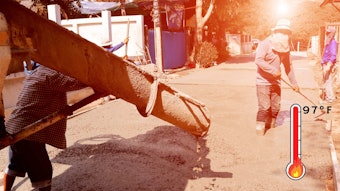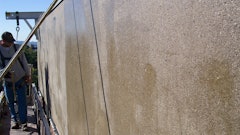When forecasting the economic outlook for the industry, the Portland Cement Association does not expect the relatively robust growth of the past three years to continue.
Oil prices are expected to retreat slowly while inflation is to remain stubbornly high. Interest rates are expected to rise at a faster pace than previously thought — both short and long term. Job growth will moderate under the dual pressures of higher oil prices and higher interest rates. Real consumer spending, accounting for more than two out every three dollars of U.S. total economic activity, will grow at a sub-3 percent rate during 2007 and beyond. These combined factors lead PCA to expect real GDP will grow 3.1 percent in 2006 followed by a sub-3 percent growth pace for 2007 and beyond.
Construction outlook
Overall construction spending is expected to record a 1 to 1.5 percent gain in 2006, followed by a 2 percent gain in 2007 and modest growth in 2008 and beyond. The construction outlook reflects sustained declines in residential construction offset by gains in nonresidential and public sector activity.
Residential Construction: Rising mortgage rates, slow growth in household income, tightening credit conditions and large inventories of unsold homes play critical ingredients in PCA's 2006 projections of a 13 percent decline in single family starts, followed by another 13 percent decline in 2007. Compared to 2005 levels, this represents a 7.1-million-metric-tonne reduction in cement consumption through 2007 — representing a 24 percent decline. These declines are expected to be amplified by an additional 1.4-million-metric-tonne decline in cement consumption targeted at the home improvement/additions sector.
PCA expects 30-year conventional mortgage rates will top 6.9 percent by mid-2007. Up to an additional 50 basis point increase in rates is expected to materialize by the end of 2007. Rising mortgage rates will be overlaid onto large principals due to strong appreciation rates recorded over the past two years. Mortgage payments, now estimated at an average of $1,400 per month for new homes, are expected to rise nearly 15 percent in 2007 — reaching an average of nearly $1,850 per month. New home affordability will erode, particularly in regions which have recorded the strongest home appreciation during the past three years, such as the West and East Coast states.
The adverse outlook facing affordability and new home sales is magnified by new home inventory conditions. The recent softening in home sales has resulted in a dramatic increase in new home inventories — which are now at record levels. Measured by average months on the market, inventories have risen from 4.1 months a year ago to 6.8 months currently — requiring a 150,000-unit inventory correction. PCA assumes a 100,000-unit correction in 2007 followed by an additional 50,000-unit correction in 2008.
Nonresidential Construction: Slower economic growth translates directly into slower growth for nonresidential construction activity in 2006 and 2007. The slower pace of economic growth implies slower improvement in nonresidential vacancy rates and slower gains in leasing rates. While the outlook remains positive, the expected returns on nonresidential investments are less robust and suggest a more moderate pace of recovery for nonresidential construction. Compared to 2005 levels, nonresidential cement consumption is expected to grow 12 percent in 2006, 8 percent in 2007 and 6 percent in 2008. By 2008, these gains represent a 4.5-million-metric-tonne gain compared to 2005 levels.
Public Construction: On the public sector side, improvement in state fiscal conditions remains a cornerstone of the current forecast. Keep in mind, 93 percent of public sector construction is performed at the state level — not the federal level. Slower job creation implies slower growth in state revenues. Severe fiscal distress is still fresh in the minds of many state budget officers. It is likely this sensitivity to fiscal distress and the growth slowdown in revenue collections will translate into a cautious approach toward new public sector construction projects. In addition, rising construction costs will reduce the ability of states to undertake the number of planned public projects. Indeed, many DOTs are already readjusting planned paving schedules. Reflecting these concerns, PCA expects public highway cement consumption will fall off its strong 2006 pace to an average 3.8 percent growth in 2007 and 2008. By 2008, public sector gains reflect a 7.7-million-metric-tonne increase over 2005 levels.
Cement consumption
Portland cement consumption is expected to reach 124 million-metric-tonnes during 2006 — reflecting a 2.8-million-tonne gain, or 0.6 percent growth, over 2005's record year. PCA expects the market will record a modest 0.3 percent growth in 2007, followed by more robust trends returning in 2008 when cement consumption is projected to increase by 2.7 percent.
The flattening of the market is the combined result of the decline in the housing industry and softer overall economic conditions. In recent years, the U.S. and cement industries have experienced unprecedented growth. However, construction activity is starting to soften and this will create an adverse impact on cement consumption.
It is important to note that PCA does not expect growth in cement consumption will be shared evenly across the United States. The Great Lakes, Northeast and mid-Atlantic states, for example, face meager growth conditions, and in some cases outright market contraction. In contrast, markets in the southern, western and mountain regions are expected to achieve somewhat stronger growth rates. The differential in regional growth rates reflects the relative strength of the regional economies as well as each state's unique exposure to declines in residential consumption.
Market conditions
To date, supply has far outstripped potential demand growth during 2006. Tight market conditions that characterized the cement market during the past two years have been dramatically reduced or eliminated. According to the PCA's recent market survey, only two states reflect tight market conditions — compared to more than 30 states in 2004 and 2005.
The reduction in market tightness is accrued to dramatic growth in import volume recorded thus far in 2006 — now running at a 42-million-metric-tonne annual rate. Compared to 2005's record import level of 33.6 million metric tonnes, import volumes are running more than 8 million metric tonnes ahead of 2005. The current import rate implies a supply overhang of more than 5 million metric tonnes.
PCA does not believe the gains in import volume can be sustained. The impressive import gains recorded throughout 2005 and into the first five months of 2006 correlate with favorable global shipping conditions. From the first quarter of 2005 through the first quarter of 2006, Asian freight rates recorded an average decline of 18 percent compared to year-earlier levels.
On the heels of resurging economic growth in China (11.5 percent real GDP growth), tight shipping conditions have recently resurfaced. Reflecting this tightness, freight rates have increased significantly. Handymax dry bulk carrier rates from Asia to the Gulf have increased 89 percent since the beginning of 2006 and now stand at more than $50 per tonne — most of these gains have materialized during the past two months. These increases suggest a more moderate pace of imports through the remainder of 2006 — particularly in the fourth quarter. PCA expects import volume will reach 37.4 million metric tonnes in 2006 and 38.5 million metric tonnes in 2007. As new domestic capacity comes online in 2008 and beyond, import volumes are expected to retreat to 30 million metric tonnes.
Cement intensity growth is key to market growth during the next couple of years. Cement intensities refer to the tonnes of cement per dollar of construction activity.
Our forecast projects that cement intensities will increase by 2 percent in 2007, fueled by a favorable relative price position vs. asphalt and steel, as well as a shift toward higher cement usage construction projects. Code changes in hurricane-prone regions, improved cement products, and concrete's growth as a "green" building material will all contribute to this despite a decrease in construction activity.
Additionally, the PCA fall forecast does not expect the sharp decline in housing to continue at the current rate. The recent downward change in the housing market was driven by the departure of speculators from the market. Their exit will actually help introduce a correction to housing prices and improve affordability for the average home buyer.



























